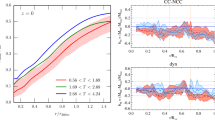Abstract
The classical 1/V a and PC methods of constructing binned luminosity functions (LFs) are revisited and compared by graphical analysis. Using both theoretical analysis and illustration with an example, we show why the two methods give different results for the bins which are crossed by the flux limit curves L=L lim (z). Based on a combined sample simulated by a Monte Carlo method, the estimate ϕ of two methods are compared with the input model LFs. The two methods give identical and ideal estimate for the high luminosity points of each redshift interval. However, for the low luminosity bins of all the redshift intervals both methods give smaller estimate than the input model. We conclude that once the LF is evolving with redshift, the classical binned methods will unlikely give an ideal estimate over the total luminosity range. Page & Carrera (in Mon. Not. R. Astron. Soc. 311:433, 2000) noticed that for objects close to the flux limit \(\phi_{1/V_{a}}\) nearly always to be too small. We believe this is due to the arbitrary choosing of redshift and luminosity intervals. Because \(\phi_{1/V_{a}}\) is more sensitive to how the binning are chosen than ϕ PC . We suggest a new binning method, which can improve the LFs produced by the 1/V a method significantly, and also improve the LFs produced by the PC methods. Our simulations show that after adopting this new binning, both the 1/V a and PC methods have comparable results.











Similar content being viewed by others
References
Avni, Y., Bahcall, J.N.: Astrophys. J. 235, 694 (1980)
Best, P.N., Röttgering, H.J.A., Lehnert, M.D.: Mon. Not. R. Astron. Soc. 310, 223 (1999)
Burgess, A.M., Hunstead, R.W.: Astron. J. 131, 100 (2006)
Cara, M., Lister, M.L.: Astrophys. J. 686, 148 (2008)
Choloniewski, J.: Mon. Not. R. Astron. Soc. 226, 273 (1987)
Christensen, C.G.: Astron. J. 80, 282 (1975)
Christlein, D., Gawiser, E., Marchesini, D., Padilla, N.: Mon. Not. R. Astron. Soc. 400, 429 (2009)
Civano, F., Brusa, M., Comastri, A., et al.: Astrophys. J. 741, 91 (2011)
Eales, S.: Astrophys. J. 404, 51 (1993)
Efron, B., Petrosian, V.: Astrophys. J. 399, 345 (1992)
Efstathiou, G., Ellis, R.S., Peterson, B.A.: Mon. Not. R. Astron. Soc. 232, 431 (1988)
Ellis, R.S., Colless, M., Broadhurst, T., Heyl, J., Glazebrook, K.: Mon. Not. R. Astron. Soc. 280, 235 (1996)
Fan, X., Strauss, M.A., Schneider, D.P., et al.: Astron. J. 121, 54 (2001)
Hiroi, K., Ueda, Y., Akiyama, M., Watson, M.G.: Astrophys. J. 758, 49 (2012)
Johnston, R.: Astron. Astrophys. Rev. 19, 41 (2011)
Johnston, R., Teodoro, L., Hendry, M.: Mon. Not. R. Astron. Soc. 421, 270 (2012)
Kelly, B.C., Fan, X., Vestergaard, M.: Astrophys. J. 682, 874 (2008)
Laing, R.A., Riley, J.M., Longair, M.S.: Mon. Not. R. Astron. Soc. 204, 151 (1983)
Lynden-Bell, D.: Mon. Not. R. Astron. Soc. 155, 95 (1971)
Maloney, A., Petrosian, V.: Astrophys. J. 518, 32 (1999)
Mao, M.Y., Sharp, R., Norris, R.P., et al.: Mon. Not. R. Astron. Soc. 426, 3334 (2012)
Marchã, M.J.M., Caccianiga, A.: Mon. Not. R. Astron. Soc. (2013). doi:10.1093/mnras/stt065
Marchesini, D., Stefanon, M., Brammer, G.B., Whitaker, K.E.: Astrophys. J. 748, 126 (2012)
McAlpine, K., Jarvis, M.J.: Mon. Not. R. Astron. Soc. 413, 1054 (2011)
McCarthy, P.J., Kapahi, V.K., van Breugel, W., et al.: Astrophys. J. Suppl. Ser. 107, 19 (1996)
Padovani, P., Miller, N., Kellermann, K.I., et al.: Astrophys. J. 740, 20 (2011)
Page, M.J., Carrera, F.J.: Mon. Not. R. Astron. Soc. 311, 433 (2000)
Patel, H., Clements, D.L., Vaccari, M., et al.: Mon. Not. R. Astron. Soc. 428, 291 (2013)
Pei, Y.C.: Astrophys. J. 438, 623 (1995)
Schafer, C.M.: Astrophys. J. 661, 703 (2007)
Schmidt, M.: Astrophys. J. 151, 393 (1968)
Singal, J., Petrosian, V., Lawrence, A., Stawarz, Ł.: Astrophys. J. 743, 104 (2011)
Takeuchi, T.T.: Mon. Not. R. Astron. Soc. 406, 1830 (2010)
Turner, E.L.: Astrophys. J. 231, 645 (1979)
Tzanavaris, P., Georgantopoulos, I.: Astron. Astrophys. 480, 663 (2008)
Willmer, C.N.A.: Astron. J. 114, 898 (1997)
Willott, C.J., Rawlings, S., Blundell, K.M., Lacy, M., Eales, S.A.: Mon. Not. R. Astron. Soc. 322, 536 (2001)
Woodroofe, M.: Ann. Stat. 13, 163 (1985)
Yencho, B., Barger, A.J., Trouille, L., Winter, L.M.: Astrophys. J. 698, 380 (2009)
Yuan, Z., Wang, J.: Astrophys. J. 744, 84 (2012)
Acknowledgements
We are grateful to the referee for very useful comments that improved this paper. We acknowledge the financial supports from the National Natural Science Foundation of China 11133006, 11163006, 11173054, the National Basic Research Program of China (973 Program 2009CB824800), and the Policy Research Program of Chinese Academy of Sciences (KJCX2-YW-T24).
Author information
Authors and Affiliations
Corresponding author
Rights and permissions
About this article
Cite this article
Yuan, Z., Wang, J. A graphical analysis of the systematic error of classical binned methods in constructing luminosity functions. Astrophys Space Sci 345, 305–313 (2013). https://doi.org/10.1007/s10509-013-1402-9
Received:
Accepted:
Published:
Issue Date:
DOI: https://doi.org/10.1007/s10509-013-1402-9



